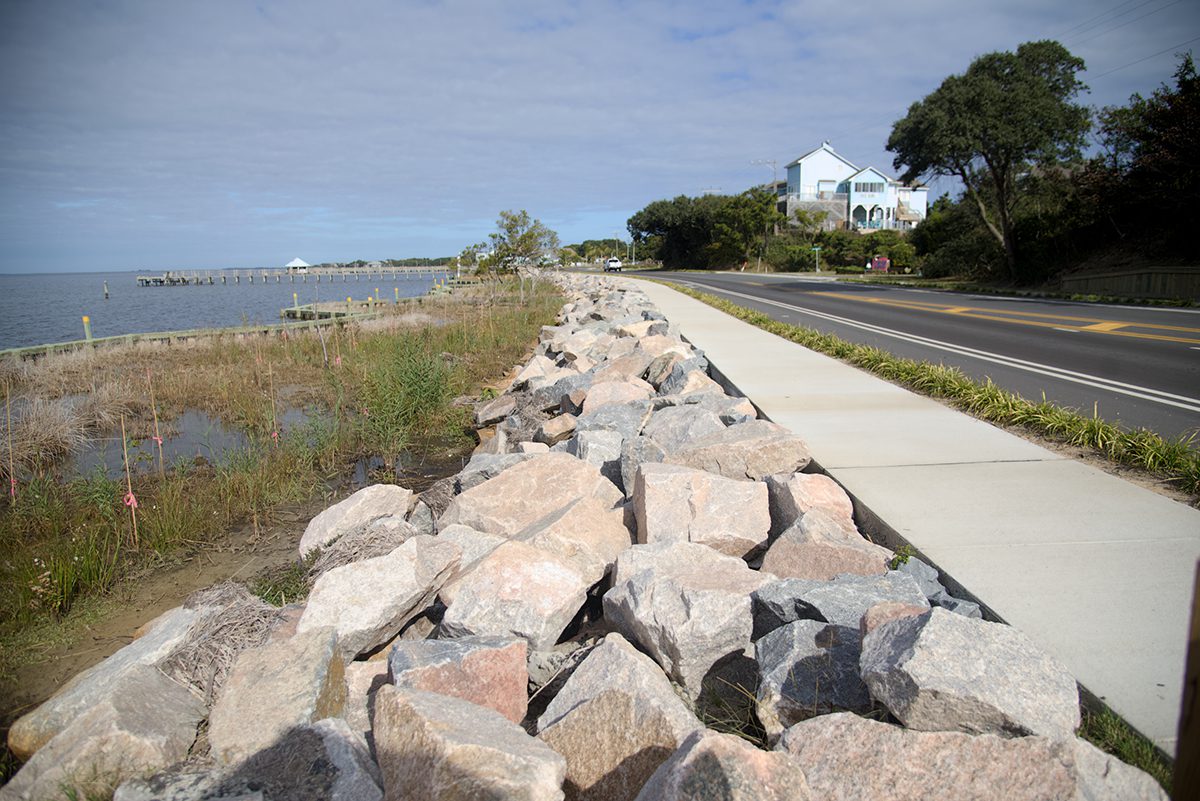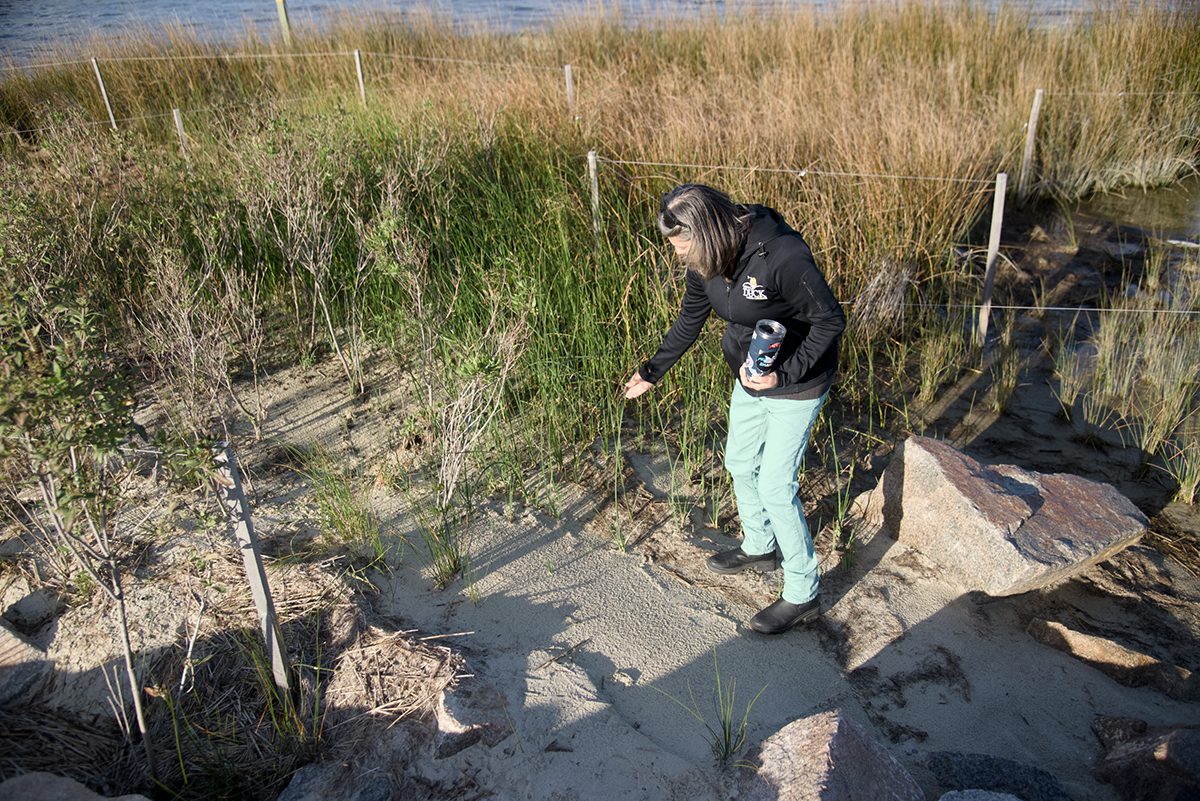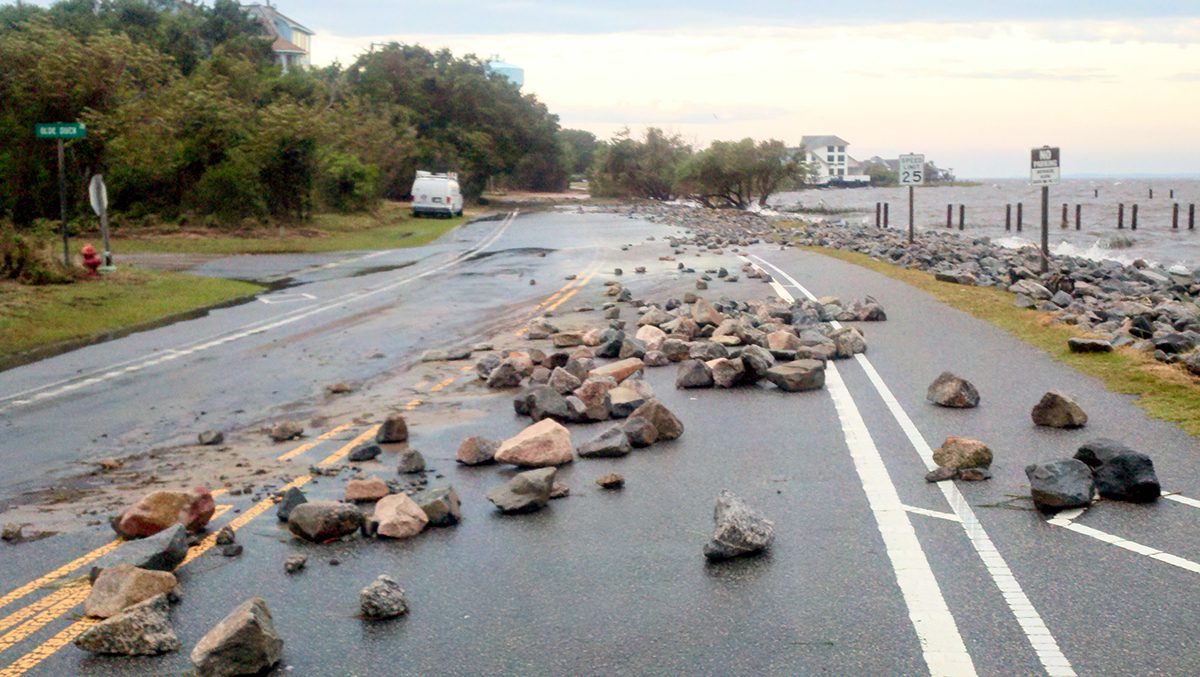
Sandy Cross, senior planner for Duck, recently brought Coastal Review with her as she walked along the edge of Currituck Sound, where a project to make the Dare County town more resilient was completed in May.
Cross excitedly pointed out signs of continuing progress at the site.
Supporter Spotlight
“See this little grass right here? This is a black needle rush or Juncus roemerianus,” she said, growing more excited as the stroll continued another 10 to 15 yards farther along the shoreline.
“Wait a minute. See this grass that looks kind of like a Charlie Brown Christmas tree?” she asked. “That’s called Spartina cynosuroides, which is a coastal wetland species. We did not plant that.”

The project funded with local, state and federal money also elevated a portion of N.C. Highway 12 to reduce flooding, and it restored native marsh to protect the shoreline and improve natural habitat.
In October, the American Planning Association recognized the project, honoring the town with its Marvin Collins Planning Award in Sustainability and Resilience.
The award-winning projects and programs were selected for their “high quality, originality, and innovation, as well as a degree of transferability,” according to the association. “They are also impactful, in that they address a known community need and position the community for a stronger, more equitable future.”
Supporter Spotlight
Most vulnerable infrastructure
N.C. 12 is the only road that connects Duck to the rest of Dare County to the south and Corolla village in Currituck County to the north. At the north end of Duck’s business district, the highway was prone to flooding. When the wind was strong enough for long enough, revetment rocks that were placed alongside the road were lifted from their bed and strewn across the highway.
“For anyone that’s been in Duck any length of time, they know that a good southwest wind will inundate the roadway,” Cross said.
Town officials knew well that the quarter-mile stretch of the road was at risk. A 2019 Western Carolina University vulnerability assessment, “indicated that this section of roadway was the most vulnerable infrastructure we had in the in the town,” Cross said.
The project cost a little more than $4.3 million, which was mostly paid for with grants, although the town did contribute $398,500 of its own. Construction began in October 2023 and took six months to complete.
Sills were installed to protect a new living shoreline. Marsh grasses were planted after the invasive phragmites reeds that had taken over the nearshore were removed. The small riprap rocks were replaced by Class III Armor Stone, revetment stones that weight more than a ton each and should withstand even the strongest winds and waves.

The roadbed was raised 2.5 feet and a new sidewalk was built, all with resilience features.
“They put in strips,” Cross said of the design, “intended as a small stormwater mechanism. They’re probably about 2 feet deep, and at the base there’s some filter cloth, and then there’s a rock bed, and then there’s bio-retention soil.”
There is also a wild grass planted between the road and the sidewalk— liriope.
In the past the town had used little bluestem between the highway and sidewalk, but Cross really wanted to find a grass that would work better as a barrier.
“They (little bluestem) get really tall, and they get really floppy when they get wet,” she said.
Liriope is a flowering grass that Cross said, “is probably the only plant that can survive the soot and the very small space in which it has to survive.”
Duck has created a series of vision documents beginning in 2009 with its “2022 Vision” that describes the town as “a pedestrian first community that is safe and easy to navigate by walking and cycling.”
That same document stressed environmental stewardship with an emphasis on living shorelines for protection on the sound side of the village.
Phase 4 of the sidewalk project was to be at the north end of the business district, and plans called for a living shoreline to create additional defense from soundside flooding.
Standing at the south end of the project area, Cross explained how the project went from an ambitious but relatively limited shoreline plan to an award-winning project, a process kickstarted by the Federal Emergency Management Agency.
“We were going put in a sidewalk, and we were going to put in a living shoreline. That was all scheduled to begin in 2019,” she said. “Then FEMA came out with their Building Resilient Infrastructures and Communities grant program and there was a huge pot of money for resilience projects.”
With possibility of funding for raising the road in conjunction with the living shoreline and sidewalk project, the town paused to “apply for this BRIC grant to raise the road and then really make it a resilience project,” Cross recalled.
The state, Cross said, said the project was a good candidate for funding but advised the town to hold off on the sidewalk and living shoreline components.
“You need to encompass it all in order to really fare well in the scoring of the grant,” she said. “So we started the grant process with BRIC in 2020. Fast-forward to 2024, when we actually saw the money for the grant.”

The roughly $1.9 million appeared to be enough to raise the roadbed and replace the riprap.
“Then COVID happened,” Cross said. “Everything you thought was going to cost one thing ended up costing double that. We were able to apply to the Department of Emergency Management with the state for some additional funding. We ended up getting an additional $1.5 million and change to offset some of the increase in cost of the project.”
There were other grants as well, including the $398,500 from the National Fish and Wildlife Foundation for the living shoreline, $148,000 from the Outer Banks Visitors Bureau for the sidewalk, and an additional $20,000 grant from the Community Conservation Assistance Program administered through the soil and water districts by the North Carolina Department of Agriculture and Consumer Services’ Division of Soil and Water Conservation.
Ricky Wiatt, senior landscape architect with environmental and government consulting firm VHB, which has long worked with the town, wrote on the company’s blog that the project, “was not merely a one-and-done solution but rather a dynamic and layered approach designed to adapt and thrive in the face of ongoing challenges. By embracing the principles of resiliency and incorporating diverse strategies, the Town of Duck is not only safeguarding its infrastructure but also fostering a more sustainable and vibrant community for generations to come.”
For Cross, however, although construction has been completed, there is still work to be done.
“We do expect this to be a case study. That’s one of the things I am continually telling people, and one of the reasons why I want to get some monitoring program together,” she said. “This is all fine and dandy, but if we don’t have a way to track it when it’s done, then what have we done it for?”








